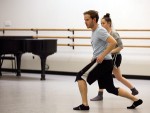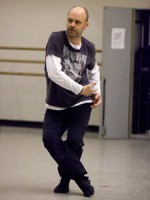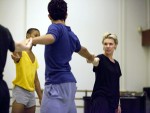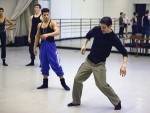Title
The four choreographers hard at work in neighboring third-floor studios this fall were creating dances marked by approaches as different as their backgrounds. Representing four countries, they brought a particularly international flavor to New Dances: Edition 2010, an annual program in which a choreographer works with an entire Dance Division class. Preparations for the culminating performances, which take place from December 15 to 19, jump-start the academic year and give the entire dance student body important exposure to up-to-the-minute, tailor-made choreography.
Body
Early on in the creative process, the first-year students were responding with verve to choreographer Matthew Neenan’s crisp, vivid directions. A partnering sequence that five couples were rehearsing draws on the choreographer’s ballet background, but he injected playful and surprising touches. One moment he demonstrated how he would like “a little jive” to give the sequence a swing-dance feel; the next he urged them to produce a cartoonish stylized walk. After working on the sequence in silence, he turned on the music, and the movements all fit quite comfortably with a string quartet by Philip Glass (M.S. ’62, composition).
Next door, 10 second-year women in kneepads repeatedly attempted a demanding passage that kept them close to the ground as they slid and twisted, crouched and crumpled, while choreographer Raewyn Hill gave them pointers and occasionally joined them to demonstrate—at one point slowly and fluidly sinking to the ground on one leg. The 10 men in the cast then went through their own moves, advancing in deep plié with a tribal, earthy emphasis. Two class members who were injured took notes, serving as Hill’s assistants.
Nearby, Luca Veggetti, who split his third-year class into two groups for early rehearsals, intently roamed the room as five couples tested and adjusted an intricate partnering sequence marked by suspended, off-center moves. They all wore socks, the better to navigate the smooth sliding movements that mark the duet passage. Veggetti offered corrections and advice: “It’s not about lifting high; it’s about reaching out,” he told one pair, then advising another “don’t get stuck in a position. It’s about constant flow.”
Choreographer Matthew Neenan (Photo by Rosalie O’Connor) In another studio, the mood was intent and meditative as the fourth-year students listened intently to the softspoken Stijn Celis. He guided them through a striking group sequence out of which solos emerged and receded organically. It was just the third week of an extended rehearsal period, but the movement, set to a spare 17th-century a cappella liturgical composition, already had a distinctive and confident design.
Dance Division artistic director Lawrence Rhodes created the New Dances series in 2003, and one goal was to expose the students to the choreographic process and give them a sense of how many ways a dance can be made. In his search for choreographers, Rhodes said, “I’m looking to find variety. People approach choreography in very different ways—with real physical material, with imagery, with improvisation.”
Just a few weeks into the rehearsals, each of the choreographers took some time from their rigorous schedules to talk about how their creative processes were unfolding. Neenan, whose work, The Second Ratio, is set to movements from Glass’s third and fourth string quartets, had the largest class—26 first-year dancers. He also has the benefit of experience, having made a piece for New Dances: Edition 2006. A longtime dancer with Pennsylvania Ballet who is now that company’s resident choreographer, Neenan co-founded Ballet X, a Philadelphia-based chamber troupe, but he has a lot of experience with bigger ensembles as well. “In my early work, I liked large groups. Still being in the corps de ballet, I was used to that—being near people, knowing how to make things work in a group.”
For his first-year students, New Dances is a crucial bonding experience that begins soon after their arrival at Juilliard. “It’s the first time they’re really showing the world who they are. I want them to look as mature as everybody else out there,” Neenan said. He is choreographing to Glass’s music for the first time, he explained, because “I thought it would be something nice for where [the students] are right now. It’s a little mysterious—not anything too classical, too pop. It has a nice maturity for them to grow with.” Despite Neenan’s strongly classical background, he noted that a lot of his work had become “more contemporary, more grounded.” He finds the Julliard dancers very responsive to this approach. “They’re so young, and the talent is enormous.”
Raewyn Hill, a New Zealander now based in Queensland, Australia, where she directs DanceNorth, has been quite the globetrotter in recent years, spending time in Hong Kong, Paris, and Moscow. She has also traveled quite a distance artistically, going from a strictly classical ballet beginning toward more contemporary work performed in the companies of Douglas Wright and others. This is the first time she has worked with American dancers.
The impetus for Hill’s choreography often springs from the visual arts. During a residency in Paris last year, she spent considerable time at the Musée Rodin, and the massive, densely populated works triggered her imagination. Her piece for the Juilliard second-year dancers takes its inspiration from Rodin’s imposing The Gates of Hell—a bronze entranceway featuring 180 figures. Rodin worked on the project for nearly four decades and included figures from Dante’s Inferno as well as some from his earlier works, such as The Thinker. “When you first look at them, they’re so beautiful,” Hill said. “But when you begin to really dissect them, they’re quite brutal, ugly, and gruesome. I began to think about how at the very core of beauty is pain; at the very core of pain is beauty.”
The Juilliard piece is called The Gates, but the dancers do not necessarily represent specific figures from Rodin’s work, rather “they’re all morphing in and out of them. Rodin would create a figure, shift it around, which in some ways reminded me of how I create choreography.”
Hill found the second-year dancers to be open and engaged: “They’ve been very receptive and very generous with committing to the concept of the work.” The piece features an original score by Spanish composer Micka Luna, a frequent collaborator, and it is based on Schubert’s Ave Maria, using an arrangement recorded by Jocelyn West as a soundscape.
Italian choreographer Luca Veggetti is now primarily based in New York. In addition to choreographing for Cedar Lake Contemporary Ballet and doing several distinctive projects at the Miller Theater, he was recently named Morphoses’ artistic director for the 2011-12 season. Veggetti works primarily with contemporary scores, and when he was approached to work with Juilliard’s third-year class, he knew he wanted to take advantage of the School’s musical resources. His piece for the third-year dancers is set to Pierre Boulez’s Anthèmes 2, a 1997 work for solo violin and electronics to be performed by third-year violinist Francesca Anderegg. “I wanted to be confronted with something that has this kind of complexity, and at the same time is very clear,” Veggetti said. “I tend to build a choreographic structure that is constructed upon a certain number of analogies with the score, and then I let the two things be in their relationship, which is alive.”
He had high praise for his Juilliard class: “The dancers are all very high level. They are not scared of launching themselves into something that is probably considerably different—in terms of quality of movement—than what they have been doing. ”
Stijn Celis, a Belgian choreographer based in Switzerland, initially planned to create a dance for the fourth-year students set to Bartok’s Romanian Dances, but he soon shifted gears musically. “When I was in front of the dancers, the Bartok didn’t feel right. Given the impression of being in New York, going through the streets, seeing life here—I thought I wanted to do something a bit softer on the soul of the dancers.” Instead, he set his piece, Facing, to Gregorio Allegri’s Miserere, set to Psalm 51 (Miserere mei, Deus) and recorded by A Sei Voci. “There is a theme of a group going through some evolution, a very strong sense of a human collective,” he said of the piece. “I wanted to make a soft, introspective piece for them—not flashy—something . . . more vulnerable that has to do more with the impermanence of being here.”
Celis has performed with a number of European ballet troupes and is a busy freelance choreographer, though few of his works have been seen in New York, with the exception of Cedar Lake’s 2008 performance of his Rite. Three weeks into his Juilliard stint, Celis was full of admiration. “I find it’s very innovative in its pedagogical approach—focused on really furthering the artist within the dancer. They’re already extremely developed, and extremely versatile—with such interesting minds,” he said.
For Rhodes, one benefit of New Dances is that it immerses students in the creative process. “You have to learn how [to] tune into what someone is looking for and come up with the right response, physically, to help build the dance. I like to imagine that the students are getting skills during the four years of this program that they’ll be able to use when they get out into the field.”








